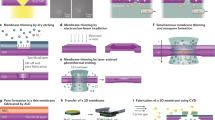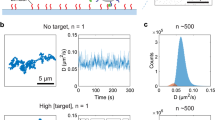Abstract
We describe a protocol for the preparation of a family of calcium indicators for MRI. The indicators consist of superparamagnetic iron oxide nanoparticles functionalized with the calcium-sensing protein, calmodulin, and its target peptides. Calcium-dependent protein–protein interactions drive particle clustering and produce large changes in T2 relaxivity. To prepare these indicators, interacting polypeptides are purified, biotinylated and then conjugated to streptavidin-coated nanoparticles. Conjugates are isolated, mixed to obtain functional sensors and incubated in the presence or absence of calcium to test response properties. Calcium-dependent responses are assayed by dynamic light scattering and MRI. The whole series of procedures can be carried out in ∼12 h. The iron oxide-based calcium sensors discussed here are suitable for the detection of calcium concentration changes of ∼1 μM in vitro.
This is a preview of subscription content, access via your institution
Access options
Subscribe to this journal
Receive 12 print issues and online access
$259.00 per year
only $21.58 per issue
Buy this article
- Purchase on Springer Link
- Instant access to full article PDF
Prices may be subject to local taxes which are calculated during checkout



Similar content being viewed by others
References
Haugland, R.P. Handbook of Fluorescent Probes and Research Products 9th edn. (Molecular Probes, Eugene, Oregon, 2002).
Helmchen, F. & Denk, W. Deep tissue two-photon microscopy. Nat. Methods 2, 932–940 (2005).
Jasanoff, A. Functional MRI using molecular imaging agents. Trends Neurosci. 28, 120–126 (2005).
Lin, Y.J. & Koretsky, A.P. Manganese ion enhances T-1-weighted MRI during brain activation: An approach to direct imaging of brain function. Magn. Reson. Med. 38, 378–388 (1997).
Li, W.H., Fraser, S.E. & Meade, T.J. A calcium-sensitive magnetic resonance imaging contrast agent. J. Am. Chem. Soc. 121, 1413–1414 (1999).
Atanasijevic, T., Shusteff, M., Fam, P. & Jasanoff, A. Calcium-sensitive MRI contrast agents based on superparamagnetic iron oxide nanoparticles and calmodulin. Proc. Natl. Acad. Sci. USA 103, 14707–14712 (2006).
Josephson, L., Perez, J.M. & Weissleder, R. Magnetic nanosensors for the detection of oligonucleotide sequences. Angew. Chem. Int. Ed. 40, 3204–3206 (2001).
Tanimoto, A., Oshio, K., Suematsu, M., Pouliquen, D. & Stark, D.D. Relaxation effects of clustered particles. J. Magn. Reson. Imaging 14, 72–77 (2001).
Perez, J.M., Josephson, L. & Weissleder, R. Use of magnetic nanoparticles as nanosensors to probe for molecular interactions. Chembiochem. 5, 261–264 (2004).
Welch, M.W., Hamar, D.W. & Fettman, M.J. Method comparison for calcium determination by flame atomic absorption spectrophotometry in the presence of phosphate. Clin. Chem. 36, 351–354 (1990).
Burguera, J.L., Burguera, M. & Alarcon, O.M. Determination of sodium, potassium, calcium, magnesium, iron, copper and zinc in cerebrospinal-fluid by flow-injection atomic-absorption spectrometry. J. Anal. At. Spectrom. 1, 79–83 (1986).
Nemutlu, E. & Ozaltin, N. Determination of magnesium, calcium, sodium, and potassium in blood plasma samples by capillary zone electrophoresis. Anal. Bioanal. Chem. 383, 833–838 (2005).
Parentoni, L.S., Pozeti, R.C.S., Figueiredo, J.F. & de Faria, E.C. The determination of total calcium in urine: a comparison between the atomic absorption and the ortho-cresolphtalein complexone methods. J. Bras. Patol. Med. Lab. 37, 235–238 (2001).
Allerheiligen, D.A., Schoeber, J., Houston, R.E., Mohl, V.K. & Wildman, K.M. Hyperparathyroidism. Am. Fam. Physician 57, 1795–1802, 1807–1808 (1998).
Shapiro, M.G., Atanasijevic, T., Faas, H., Westmeyer, G.G. & Jasanoff, A. Dynamic imaging with MRI contrast agents: quantitative considerations. Magn. Reson. Imaging 24, 449–462 (2006).
Green, D.F., Dennis, A.T., Fam, P.S., Tidor, B. & Jasanoff, A. Rational design of new binding specificity by simultaneous mutagenesis of calmodulin and a target peptide. Biochemistry. 45, 12547–12559 (2006).
Palmer, A.E., Jin, C., Reed, J.C. & Tsien, R.Y. Bcl-2-mediated alterations in endoplasmic reticulum Ca2+ analyzed with an improved genetically encoded fluorescent sensor. Proc. Natl. Acad. Sci. USA 101, 17404–17409 (2004).
Palmer, A.E. et al. Ca2+ indicators based on computationally redesigned calmodulin-peptide pairs. Chem. Biol. 13, 521–530 (2006).
Arbab, A.S. et al. A model of lysosomal metabolism of dextran coated superparamagnetic iron oxide (SPIO) nanoparticles: implications for cellular magnetic resonance imaging. NMR Biomed. 18, 383–389 (2005).
Perez, J.M., Josephson, L., O'Loughlin, T., Hogemann, D. & Weissleder, R. Magnetic relaxation switches capable of sensing molecular interactions. Nat. Biotechnol. 20, 816–820 (2002).
Sambrook, J., Fritsch, E.F. & Maniatis, T. Molecular Cloning : A Laboratory Manual (Cold Spring Harbor Laboratory, Cold Spring Harbor, New York, 1989).
Laemmli, U.K. Cleavage of structural proteins during the assembly of the head of bacteriophage T4. Nature 227, 680–685 (1970).
Gruber, H.J., Kada, G., Marek, M. & Kaiser, K. Accurate titration of avidin and streptavidin with biotin-fluorophore conjugates in complex, colored biofluids. Biochim. Biophys. Acta 1381, 203–212 (1998).
Acknowledgements
This work was generously funded by the Raymond and Beverley Sackler Foundation, the McKnight Endowment Fund for Neuroscience and the National Institutes of Health (R21 EB005723 to A.J.). A.J. is a Raymond and Beverley Sackler Foundation Scholar. The authors are grateful to Atsushi Miyawaki for the Xenopus CaM D64Y E104Q template sequence.
Author information
Authors and Affiliations
Corresponding author
Rights and permissions
About this article
Cite this article
Atanasijevic, T., Jasanoff, A. Preparation of iron oxide-based calcium sensors for MRI. Nat Protoc 2, 2582–2589 (2007). https://doi.org/10.1038/nprot.2007.377
Published:
Issue Date:
DOI: https://doi.org/10.1038/nprot.2007.377
This article is cited by
-
Hydrothermal synthesis of monodisperse dodecahedron α-Fe2O3 nanocrystals with high photocatalytic activity
Journal of Materials Science: Materials in Electronics (2014)
-
Investigation of the photodegradation properties of iron oxide doped mesoporous SBA-15 silica
Journal of Porous Materials (2013)
Comments
By submitting a comment you agree to abide by our Terms and Community Guidelines. If you find something abusive or that does not comply with our terms or guidelines please flag it as inappropriate.



